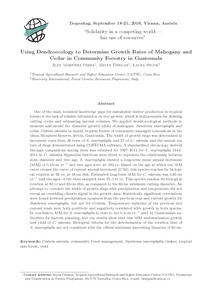Timber smuggling in Indonesia critical or overstated problem?: forest governance lessons from Kalimantan
Towards equitable partnerships between corporate and smallholder partners: relating partnerships to social, economic and environmental indicators: workshop synthesis
An important means of expanding plantation production and benefiting small-scale producers is through corporate smallholder partnerships that establish agreements for industries to purchase wood produced by other parties, including but not limited to smallholders. The workshop, and subsequent synthesis described in this document, attempted to bring together the perspectives of the private sector, government, non-governmental organizations and research institutions who are actively working on this important topic.
Towards wellbeing in forest communities: a source book for local government
Governments in many countries are decentralising to give more control over decision making and budgets to local administrations. One expectation of this change is that local governments will more effectively and efficiently respond to the poorest citizens in their jurisdictions. Decentralisation is especially significant to forest communities, which have historically benefited little from government services and poverty reduction programmes because of their physical isolation and social marginalisation.
Tropical secondary forests in Nepal and their importance to local people
Most forests in tropical Nepal are secondary, resulting largely from episodes of large-scale timber harvesting in the past along with accumulated small scale extraction of timber and non-timber forest products by local people over centuries. Currently in the forest depleted stage, remaining tropical secondary forests are still very important for fulfilling the subsistence and economic needs of local people, as well as for biodiversity conservation, groundwater recharge, and the protection of lowland agriculture from landslides and floods.
Understanding conflict in the co-management of forests: the case of Bulungan Research Forest
The paper describes underlying causes of conflicts between local people in Bulungan Research Forest (BRF), Indonesia with coal-mining and logging companies. Results show that conflict between local people and mining companies was triggered by the fact that mining operation caused water and air pollution and soil degradation. Another cause for such a conflict was the compensatory facilities (e.g. clean water, electricity, compensation fee, etc.) provided by the companies to local people were often delayed or unsatisfactory.
Understanding patterns of resource use and consumption: a prelude to co-management
For co-management of conservation areas to be effective, detailed information on local people's use of natural resources is essential. One method to obtain some of that information, a household record keeping study, is given. It is simple to implement and analyse, and provides useful, quantitative data on resource use and income levels. The method and present data derived from three studies of Melayu and Iban communities in and around the Danau Sentarum Wildlife Reserve in West Kalimantan, Indonesia, are described.
Upaya-upaya baru membentuk interaksi pemerintah dan masyarakat
Using dendroecology to determine growth rates of mahogany and cedar in community forestry in Guatemala
One of the main technical knowledge gaps for sustainable timber production in tropical forests is the lack of reliable information on tree growth, which is indispensable for defining cutting cycles and estimating harvest volumes. We applied dendroecological methods to measure and model the diameter growth (dbh) of mahogany Swietenia macrophylla and cedar Cedrela odorata in humid tropical forests of community-managed concessions in the Maya Biosphere Reserve, Petén, Guatemala. The width of growth rings was determined in increment cores from 32 trees of S. macrophylla and 27 of C.
Who counts most? assessing human well-being in sustainable forest management
Who Counts Most? Assessing Human Well-Being in Sustainable Forest Management presents a tool, ‘the Who Counts Matrix’, for differentiating ‘forest actors’, or people whose well-being and forest management are intimately intertwined, from other stakeholders. The authors argue for focusing formal attention on forest actors in efforts to develop sustainable forest management.


